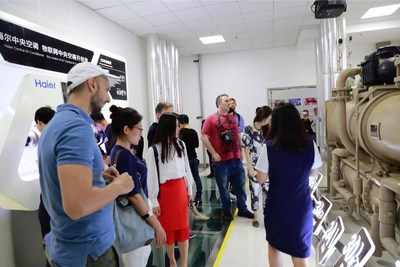Information Office of the People's Government of Shandong Province Invites Foreign Journalists to Explore Qingdao's Development Model in Shandong
QINGDAO, China, Sept. 11, 2018 /PRNewswire/ -- The Information Office of the People's Government of Shandong Province invited foreign journalists to witness firsthand the advances of Qingdao in recent years. "Normally, seaports are crowded and noisy," said Christopher Aleksi Georgiou, a journalist from the United Kingdom at the fully automated container terminal of Qingdao Port in east China's Shandong Province. "I'm amazed at how the terminal is operating in such an orderly manner with nobody in sight." Indeed, the terminal has become very efficient with state-of-the-art technologies such as big data, cloud computing and the Internet of Things (IoT). Georgiou was pleasantly surprised to learn that cargo could be transported from Qingdao to Amsterdam in only 15 days.
There is nobody in sight. But container trucks are traveling here and there on their own. Stacking forklifters are getting over the containers. The journalists saw for themselves Chinese efficiency in action.
Qingdao Port is located in Jiaozhou Bay on the southern shore of the Shandong Peninsula. It is an important hub on the Belt and Road and an important international maritime transport hub on the west coast of the Pacific Ocean. Its container terminal, Asia's first fully automated terminal, began its commercial operation in May 2017.
According to Luan Baobo, deputy general manager of the terminal, the terminal has been operating at 30 TEUs per hour, a lot more efficient than traditional labor intensive terminals. The average efficiency of individual cranes is 50 percent higher than the average in the world. Its record efficiency proves to be a low-cost, high-efficiency, zero-emission Chinese solution.
French journalist Buffet Julien compared the Qingdao Port terminal with Le Havre, an intelligent port built in northern France in 2017. He believes that the Qingdao Port terminal has set a very good example for the construction of the Digital Silk Road. He hopes that the two intelligent ports can get connected organically for better interconnectivity around the world.
Apart from the terminal, the journalists on this journey also showed great interest in CRRC Qingdao Sifang Company, a production base of high-speed trains. They visited the production line of high-end coaches/passenger cars, which produced the country's first EMUs (electrical multiple units) designed to travel at speeds of 200 km/h, 300 km/h and 380 km/h, respectively. The company was also the producer of the country's first Fuxing EMUs and first inter-city bullet trains.
Greek journalist Vasilis Trigkas believes that favorable industrial policy and long-term strategic economic planning have contributed to China's success story of railway and Shandong's development. With its advantage in the scale economy, a country supported by smart industries can provide better, more affordable goods for other markets in the long run, he asserted.
From a European point of view, he believes that the EU should promote its scale economy by planning its own industrial policies and increasing its domestic productivity, rather than closing its doors to international competition and rejecting market competition. What is noteworthy is that Sifang has established overseas R&D centers in Germany, the UK and Thailand, attracting global human capital and providing jobs for foreign markets.
At Haier COSMOPlat, the world's leading internet platform linking with users and implement large-scale customization, the journalists were impressed with the unique digital business model that is geared towards the mass individualization instead of traditional model of mass production. "We have seen more evidence of the upgrading of Chinese manufacturing," said Trigkas.

On this media journey, the foreign journalists felt that China's future development will not simply depend on first-tier cities such as Beijing, Shanghai and Shenzen. Second-tier cities such as Qingdao are also on their way to comprehensive development, with their advanced manufacturing, high-quality foreign direct investment, logistical services, highly recognizable brands and high-level tourist services. For China, the national economy will continue to develop steadily in a more comprehensive manner, and deeper reform and opening-up will be the key driver.
SOURCE Information Office of the People's Government of Shandong Province
News published on and distributed by:



